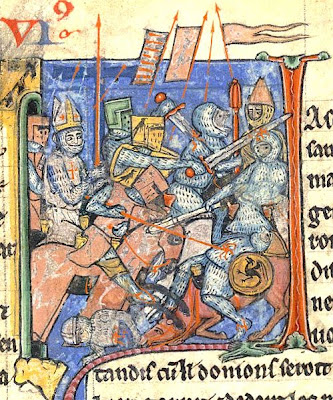"But coming to Jesus, when they saw that He was
already dead, they did not break His legs...But one of the soldiers pierced His
side with a spear .." John 19:33-34 Bible

The Holy Lance -
is the name given to the lance that pierced Jesus' side as he hung on
the cross in John's account of the Crucifixion...
Also known as the Spear of Destiny, Holy Spear, Lance of
Longinus, Spear of Longinus or Spear of Christ....
The lance is
mentioned only in the Gospel of John (19:31–37) and not in any of the Synoptic
Gospels... The gospel states that the
Romans planned to break Jesus' legs, a practice known as crurifragium, which
was a method of hastening death during a crucifixion. Just before they did so,
they realized that Jesus was already dead and that there was no reason to break
his legs. To make sure that he was dead, a Roman soldier (named in
extra-Biblical tradition as Longinus) stabbed him in the side...
The Bible not identifies a Roman soldier pierced Jesus'
side - but other sources (Gospel of Nicodemus, the fourth century.) Mentioned
the name Longines ...
Lance belonged to the Holy Roman Empire and was stored in
a large cross, inside the Imperial ...
Legend has it that he who has the Lance is immortal and
omnipotent, which takes the power of God ... The Lance from Vienna to Nuremberg
transported by the nazis - to collect all the relics of its ancient occult
rituals ...
 Relics claimed to be the Holy Lance
Relics claimed to be the Holy Lance
There have been three or four major relics that are
claimed to be the Holy Lance or parts of it...

Vatican lance - A mitred Adhémar de Monteil carrying one
of the instances of the Holy Lance in one of the battles of the First Crusade
...No actual lance is known until the pilgrim Antoninus of Piacenza (AD 570),
describing the holy places of Jerusalem, says that he saw in the Basilica of
Mount Zion "the crown of thorns with which Our Lord was crowned and the
lance with which He was struck in the side"...

Echmiadzin lance - The Holy Lance in Echmiadzin - In
1655, the French traveler Jean-Baptiste Tavernier is the first Westerner to see
this relic in Armenia ... A Holy Lance (in Armenian Geghard) is now conserved
in Ejmiadzin, the religious capital of Armenia. The first source that mentions
it is a text "Holy Relics of Our Lord Jesus Christ", in a thirteenth
century Armenian manuscript...

Vienna Lance (Hofburg spear) - The Holy Lance in the
Schatzkammer of Vienna - The inscription on the Holy Lance ... The Holy Roman
Emperors had a lance of their own, attested from the time of Otto I (912-973)...
Recently, in various churches, there are some relics,
which are considered holy, or Destiny, the spear. They are stored in the
Vatican, Vienna, Krakow (Poland) and Echmiadzin (Armenia) ... But what really
is and which of them is not a copy, it is still a mystery ... How to remain a
mystery and the fate of the spear ... It is obvious that something is wrong, if
the spears are few. Apparently, the myth of the Holy spear was so alive, and
that there were others like spears, which are united by a common idea ...

 Listen here:
Listen here:
Ancient Mysteries: The Quest for the Holy Lance

 Hitler And The Holy Lance
Hitler And The Holy Lance
The one with perhaps the best claim,
or at least the oldest provenance is in the Hofburg
Museum in Vienna , Austria
Napoleon attempted to take the Holy Lance following the
Battle of Austerlitz, but, unfortunately for him, it had already been smuggled
out of Vienna just prior to the battle, and he never secured it...
The spear finally wound up in the possession of the House
of the Habsburgs and by 1912 was part of the treasure collection stored in
Hofburg Museum. According to Ravenscroft it was in September of that year,
while living in Vienna and working as a watercolor painter, that a young Adolf
Hitler visited the Museum and learned of the lance and its reputation. Dr.
Walter Stein, who accompanied Hitler on that visit, remembered, "when we
first stood side by side in front of the Spear of Destiny it appeared to me
that Hitler was in so deep a condition of trance that he was suffering almost
complete sense-denudation and a total lack of self-consciousness."...
Hitler later said, "I stood there quietly gazing
upon it for several minutes quite oblivious to the scene around me. It seemed
to carry some hidden inner meaning which evaded me, a meaning which I felt I
inwardly knew yet could not bring to consciousness...I felt as though I myself
had held it before in some earlier century of history. That I myself had once
claimed it as my talisman of power and held the destiny of the world in my
hands..."
Hitler saw the lance as his mystical connection with
generations of conquering Germanic leaders that had come before him. On March
14, 1938, after he had risen to power as the chancellor of Germany, Hitler
annexed the state of Austria and ordered that the spear, along with the rest of
the Habsburg collection, be sent to the city of Nuremberg, heart of the Nazi
movement....
Ravenscroft reveals much of the absolute Satanism which
physically possessed Hitler. If you want to get an idea of how the real
Antichrist is going to think, act, and plan, you need to read this
"inside" account of Ravenscroft. Much of Hitler's actions during
World War II make sense only when you realize how his occultist mind set caused
him to act the way he did. Secular historians miss much of the point of
Hitler's more bizarre actions...
It is difficult to understand the horrors of war ... the
war and there are images of scriptures, the Bible ... Hitler was MARKED Human
of Heaven ... This mysterious people - with a mysterious presence on the Earth
... An old legend says: "managing the spear and understanding as to what
forces it serves as the world's fate in their hands - in good or evil ... The
bottom line is that the way this wonderful weapon combines what is inconsistent
- Good and Bad ...
Hitler - as know,
the Cetus.. . Mercury in the end of the Aries, and the Sun in 1st degree of a
Taurus... The Twelfth Sign – the
WHALE... Last sign on the Upper Zodiac.
The Twelfth Sign - between a Taurus and Aries. .. This constellation Cetus…

 Read here:
Read here:
MARKED Human of Heaven (Upper Zodiac)

 Šventoji ietis
Šventoji ietis
"Priėję prie Jėzaus ir pamatę, kad Jis jau miręs,
jie nebelaužė Jam blauzdų, tik vienas kareivis ietimi perdūrė Jam šoną .."
Jono 19,33-34 Biblija

Šventoji ietis (Longino ietis) - ieties, kuria buvo
perdurtas nukryžiuoto Jėzaus Kristaus kūnas, pavadinimas... Tai yra viena iš krikščionybės relikvijų...
Mūsų laikais egzistuoja kelios ietys, laikomos Longino ietimis...
Ietis paminima tik Jono evangelijoje (19,31-37)...
Pasakojama, kad romėnai, norėdami paspartinti Jėzus mirtį, iš pradžių planavo
sulaužyti jam kojas, bet pastebėjo, kad jis jau miręs, todėl to nedarė. Vienas
romėnas paėmė ilgą ietį ir perdūrė ja Jėzaus šoną...
Biblijoje neįvardinamas romėnas kareivis, perdūręs Jėzaus
šoną, - bet kituose šaltiniuose (Nikodemo evangelijoje, IV a.) minimas vardas
Longinas...
Ietis priklausė Šventajai Romos imperijai ir buvo saugoma
didelio imperatoriškojo kryžiaus viduje...
Legendos pasakoja, kad tas, kuris turi šią ietį yra
nemirtingas ir visagalis, nes įgauna galių iš Dievo... Šią ietį iš Vienos į Niurnbergą išgabeno
naciai,- siekdami surinkti visas
senąsias relikvijas savo okultinėms apeigoms...
 Kitos ietys
Kitos ietys
Trys ar ketverios
relikvijos, kurios, kaip tvirtinama, yra Šventa Ietis ar jos dalys...
Apie Šventosios Romos imperijos relikviją - Longino ietį
- istoriniuose šaltiniuose užsimenama jau nuo imperatoriaus Otono I laikų
(912-973)... Otonas III apie 1000 m. buvo liepęs pagaminti dvi Šventosios
ieties (dabar saugoma Vienoje) kopijas, kurių vieną perdavė Lenkijos karaliui
Boleslovui I Narsiajam. Lenkiškoji „šventoji“ ietis nuo 1200 m. saugoma
Krokuvoje...
Kryžiaus žygių relikvijos - Pirmojo kryžiaus žygio
laikais kryžiaus žygio dalyviai užimtame Antiochijos mieste rado ietį, kurią
pavadino „Šventąja Antiochijos ietimi“...
Armėniškoji ietis - Apaštalas Tadas Judas turėjęs ietį,
su kuria buvo perdurtas Jėzaus šonas ant Golgotos kalno, nugabenti į Armėniją,
kur ji buvo saugoma 40 km nuo Jerevano esančiame vienuolyne...
Vienos ietis - Šventoji Romos imperija turėjo relikviją -
ietį, kuri taip pat laikoma Longino ietimi. 1424 m. Zigmantas Liuksemburgietis
išgabeno šią ietį iš Prahos į Niurnbergą, kur jo įsakymu ji turėjo būti saugoma
per amžius...
Pastaruoju metu įvairiose pasaulio bažnyčiose yra kelios
relikvijos, kurios laikomos Šventąja, arba Likimo, ietimi. Jos saugomos
Vatikane, Vienoje, Krokuvoje (Lenkija) ir Ečmidziane (Armėnija)... Tačiau kaip
yra iš tikrųjų ir kuri iš jų ne kopija, iki šiol lieka mįslė... Kaip tebėra
mįslė ir pačios ieties likimas...
Akivaizdu, kad kažkas yra ne taip, jei tų iečių yra kelios. Matyt,
Šventosios ieties mitas buvo toks gyvas, kad egzistavo ir kitos panašios ietys,
kurias vienijo bendra idėja...
 Šventoji ietis ir Hitleris
Šventoji ietis ir Hitleris
Sena legenda skelbia: „Valdantis šią ietį ir suprantantis,
kokioms jėgoms ji tarnauja, laiko pasaulio likimą savo rankose – gerose arba
piktose“... Esmė ta, kad nuostabiu būdu
šis ginklas savyje suderino tai, kas nesuderinama – Gėrį ir Blogį ...
Kiekvienais metais galingosios relikvijos šlovė vien tik
augo, kaip ir augo norinčiųjų ją įsigyti skaičius, nes krikščionys tiki, kad
Likimo ietis yra neįtikėtinos galios šaltinis. .. Tačiau pati
svarbiausia Longino ieties valanda išmušė XX amžiuje. A.Hitleris, garsėjęs
domėjimusi mistika ir astrologija, visuomet siekė užvaldyti stebuklingąją ietį.
Istorikai liudija, kad dar jaunystėje jis valandomis stovėdavo Vienos menų
istorijos muziejuje prieš vitriną,
kurioje buvo demonstruojama relikvija.
Kai Austrija tapo Trečiojo reicho dalimi, A.Hitleris Longino ietį
paskelbė „imperijos turtu“. Pradėdamas Antrąjį pasaulinį karą jis šventai
tikėjo, kad turėdamas šią relikviją sugebės užkariauti visą pasaulį...
Sunku suvokti karo baisybes ...Karo vaizdai egzistuoja ir
šventraščiuose, Biblijoje ... Hitleris
buvo tarp Dangaus Paženklintųjų ... tai paslaptingi žmonės – su paslaptingomis
misijomis žemėje ...

 Skaityti:
Skaityti:
MARKED Human of Heaven (Upper Zodiac)


















